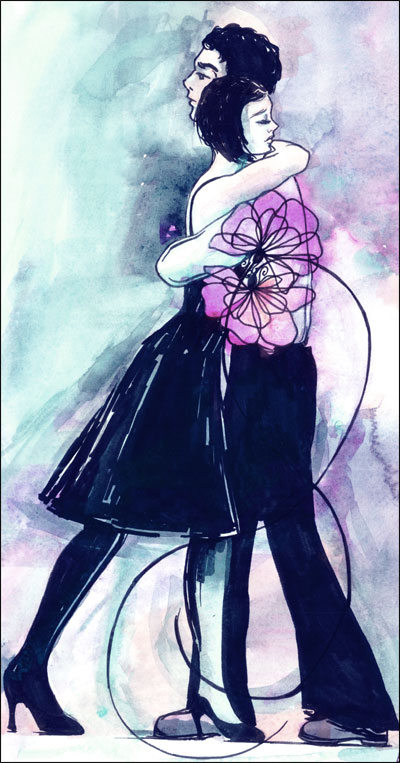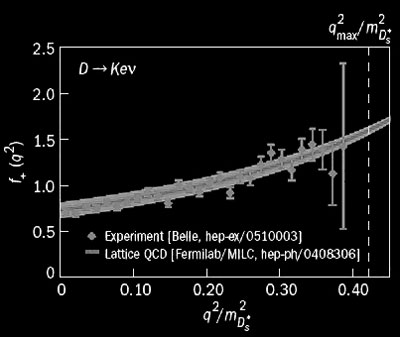The Tango, the Quark, and the Allegory of Love
Please welcome guest blogger Eden Gallanter! Eden is a painter and writer. She also works on sustainable urban planning and restoration ecology in landscape architecture. In addition to these talents, Eden is an accomplished tango dancer. In this article, Eden tells tales of subatomic physics and Mannerist painting – and what they have to do with tango, a fascinating dance form not yet covered on Coilhouse. Enjoy! – Ed.

Article and illustration by Eden Gallanter
Argentine Tango is the most difficult of all partner dances. Intimidating, overwhelming, and endlessly complex, one may reasonably wonder at the continued prominence of social Tango dancing. After all, beginners can expect to spend many months in practice before venturing out to a Tango dance (called a Milonga), and even then, most dancers must endure a few years, at least, of rampant unpopularity. Even those who are skilled in other partner dances, such as Swing, Salsa, or Waltz, usually find themselves disconcertingly back at beginner level when learning the Argentine Tango. Everything you hated about your middle school dance instruction (whether this involved a finishing school-style class in ballroom dancing or just a traumatic experience at a school dance) is amplified, all of your insecurities lining up to greet you if you decide to learn Tango, the most demanding of all social dances.
Then what are people coming back for? The truth is, it’s the very qualities that make Tango so difficult that also make it so rewarding. Tango isn’t hard because of all the moves you must learn, it is hard because it relies on the partner connection more than any other dance. If you’re dancing a Viennese Waltz and your partner doesn’t know what he or she is doing, you can at least dance the correct steps anyway and hope that your partner catches on– but if you’re dancing a Tango, this is next to impossible. You can’t move a single step if your partner can’t feel where you are, or where you’re going. Leaders have somewhat more control over this connection than followers do, but the lesson is the same: without a physical understanding of the position and direction of your partner, there is no dance. In Tango’s closed position, the two of you are leaned against one another, the centers of your chests aligned. You are sharing a single gravitational axis, and, for better or for worse, you move as one. This is precisely what makes this dance both terrifyingly difficult and, at the same time, perilously, wonderfully, heart-stoppingly intimate.
Bautiful tango video to post from a festival in Montreal set to Cat Power’s weird, moody cover of “(I Can’t Get No) Satisfaction.”
This heavy emphasis on partner connection doesn’t mean there aren’t plenty of moves to learn in Tango. There is an amazing array of styles, steps, and decorations to learn, though all depend strongly on the partner connection in order to work. The boleo contra (“throw against,” in Spanish) is made with a bent knee while the whole body rotates, drawing a graceful circle in the air with the toe. The boleo contra results from an abrupt change of direction between you and your partner, releasing the energy of opposite motion; done quickly, it feels like the beating of wings, each partner using the other’s momentum to execute a series of brief kicks.
The partner connection is not the only relationship that matters on the dance floor, though it is of the most vital importance. The best instructors in Buenos Aires teach that there are in fact no less than five “partners” in a single dance: the partner, the floor, the other couples, the music, and yourself. Tango dancers (called tangueros) must constantly pay attention to all of these. For instance, if a follower does not move to the tempo of the music, the leader will not be able to stay on beat either, and a vital framework for the communication of one another’s movements is lost. Negotiating relationships with all five “partners” is essential to the dance, even though all do not require equal attention (and, in fact, for the follower there are only four partners, as it is the leader’s job alone to manage their spatial relationship to the other dancing couples). If tangueros look overly serious when dancing, it is only because their attention is engaged fully in the demands of the dance.
If all of this is fast becoming impossible to even imagine gaining a mastery of, rest assured it’s impossible for even the most skilled dancers. Nobody can think about all the essential parts of Tango, just as nobody can reason through every part of a social encounter. At a certain point, the subconscious takes over, learned behaviors go on autopilot, and muscle memory fills in the details. Experienced Tango dancers say that the best dances happen with a bare minimum of conscious thought. The less they think, the less the leaders plan what move they’re going to do next, the less the followers try to react in the right way, and the better the dance goes. Those watching a Milonga in progress curiously observe followers dancing with closed eyes and leaders gliding across the floor with their eyelids at half-mast, deep in the embrace of their partners. This lack of conscious attention in Tango dancers can be described as a leap of faith. The dancers don’t expect anything. Instead, they trust in their training, their experience, and their intuition. The leap of faith is made blind. Tangueros must improvise everything, and trust without any grounds at all that their partner can read their minds through the most delicate and subtle of movements. They are aglow with an unconquerable belief in themselves and in their partners to move together across the floor, along with the beat and harmony of the music.

In 1964, Murray Gell-Mann made his own leap of faith. He postulated the quark, a subatomic particle belonging to a realm of physics called quantum mechanics. All physicists in this field are, in a very real way, working blind, for quantum mechanics governs a tiny world that behaves is a way that is totally unrecognizable to the human mind. Subatomic particles are far too tiny to be seen, and break nearly every law of Newtonian physics, a framework that describes the world familiar to us. Richard Feynman, a contemporary of Gell-Mann and one of the most brilliant scientists of the 20th century, said: “nobody understands quantum mechanics,” an endlessly quoted statement which is still true today.
When Gell-Mann began his work with quarks, he not only had no evidence whatsoever that could support his theory (a common situation in which any scientist might find himself), but also no real understanding of the particle he had postulated, due to the freaky physics of the subatomic world. In order to explain the internal composition of known particles, such as protons and neutrons, Gell-Mann needed eight quarks. This eight-quark model was a part of a classification scheme of his that he named the “Eightfold Way,” after the Buddhist Eightfold Path to Enlightenment—it was the 60s, after all. This theory was in the end supported by experimentation, but the last of the eight quarks would not be found until 1995; Gell-Mann had to work with an unsubstantiated set of particles as the keystone to his career for thirty years. It takes a special kind of courage to deal with a subject that is absolutely vital, but ultimately incomprehensible. This courage transcends science, and may be reasonably assigned to the realm of mysticism.
Gell-Mann’s belief in himself, and in his own scientifically trained mind and intuition –caught in the very teeth of the howling wilderness of quantum physics— is the same kind of reckless confidence that any given tanguero must have. When a couple at a Milonga dances together, the leader takes charge by moving in a way that communicates an intention, making clear to the follower what will happen next. The follower, once understanding this intention, may respond with a variety of different movements, so long as they continue to foster and strengthen the partner connection. Without conviction, the leader cannot communicate an intention to the follower, and the follower cannot interpret the intentions of the leader. In each case, it is imagination that rushes in to destroy uncertainty, collapsing the unbearable distance between two people, moving as one. But imagination (faith) is not enough; it is courage (the leap) that launches us forward.
But forward into what? What is the goal of Tango? Observing a tanguero’s obsessive preoccupation with the dance, a non-dancing friend might tentatively ask if the hope is to someday compete. Yet competitive dancing is not a part of traditional Tango, and most who dance don’t necessarily wish to teach or perform. The Milonga is a place where the values and objectives of day-to-day life fall away. Your looks, your money, your job, and your responsibilities all fall away in favor of getting one more dance. Only the ability to create and use a partner connection matters; excellent dancers are treasured by those experienced enough to appreciate them. The goal is the process itself; or, to be absolutely just, there is no goal. Tango is its own reward.
This value of process over objective seems as subversive in today’s capitalist society as it did in the late Italian Renaissance, when artists, after scientific advances had given them the rules of anatomy, proportion, and perspective, began to intentionally break the rules of realistic painting. This turn towards artifice, stylization, and proportions distorted in the name of elegance, was known as the Mannerist movement, and it is today (as it often was in its own day) scorned and ridiculed by artists and art critics. Indeed, Mannerism sometimes resulted in comically elongated figures, melodramatic attitudes, and precarious positions. Sometimes a gown or a crown would be painted with such loving attention that it would have more personality than the portrait’s subject, which, one imagines, could not have pleased the royal models. But at its best, Mannerism was about something truly profound: a love of the refinement of painting technique, and, through the manner and style of that technique, a unified concept of transcendent beauty. This unrestrained delight in the process, exulting in painterly detail and exaggerated artifice, made Mannerism difficult for goal-oriented art movements to understand. Mannerists only wished to imitate art itself, to enjoy painting as a technique, as Tango seeks only to delight in the partner connection, without thought to anything beyond what helps the couple stay connected in motion.

Agnolo Bronzino was a Mannerist painter, widely celebrated for his skill and his uncanny depictions of supernaturally beautiful human subjects. He was especially talented at exquisitely detailed paintings, both pagan and Christian, which were so popular in that day. One of his most acclaimed (and disdained) paintings, The Allegory of Love, depicts Venus and Cupid in one another’s arms, surreptitiously in the act of stealing the other’s most prized possession. They are both vulnerable and risking everything, making love and making war, a perpetual cycle without end. It exemplified the Mannerist attitude towards art: there was no lofty aspiration to make a grand statement, to change the world, or to cause a shift in human perception. There was only the glory of form, the brilliancy of color, and the joy in painting what is beautiful. Tangueros find joy in the act of dancing, and although this is not to say that they do not endeavor to learn (in fact, tangueros usually practice and take classes obsessively, no matter what level they are), there is no ultimate prize they ask for, other than to be a part of sublimely wonderful dances, again, and again, and again.
To observers, Tango may seem like nothing much: just couples pressed together, slowly walking around the floor. To the couples, though, it’s an experience of intense concentration, every nerve straining to sense the position of the partner, every muscle ready to communicate movement or to react. Sharing a gravitational axis, hearts pressed together, compelled to trust each other at a fundamental, physical level, no room remains for ambition or desire. Tango demands courage and it demands imagination, and in sacrificing our expectations, we find an invulnerable faith in ourselves, waiting for us at the end of desire.

October 17th, 2011 at 4:58 pm
This was an intensely fascinating read. Wonderful!
October 17th, 2011 at 9:26 pm
Blues dancing works the same way. Except there are no set steps or combos. It’s a leap of faith and it’s both terrifying and wonderful.
October 17th, 2011 at 11:17 pm
Bronzino’s Allegory is the subject of my historical novel Cupid and the Silent Goddess, which imagines how the painting might have been created in Florence in 1544-5.
See:
http://www.twentyfirstcenturypublishers.com/index.asp?PageID=496
October 18th, 2011 at 11:11 pm
Reading this article felt like struck by Cupid’s arrow… had to read it twice. Thank you!
October 19th, 2011 at 2:00 am
This is beautifully written and I will be forwarding the link to all my Tanguero friends. Thank you Eden!
October 20th, 2011 at 5:08 pm
[…] Gallanter talks about The Tango, The Qark, and the Allegory of Love on Coilhouse: One of his most acclaimed (and disdained) paintings, The Allegory of Love,depicts […]
November 21st, 2011 at 4:22 pm
This article embodies everything that I believe about the dance…it fosters human connection as well, which is so badly lacking in our modern society. I find tango to be overwhelmingly complex, which is the reward and the challenge. Life is such an amazing gift and I choose to use it dancing the tango and sharing my energy with the other beings around me that wish to also dance and move their Universe-given bodies.
September 27th, 2012 at 6:23 pm
you young people enjoy being young
September 27th, 2012 at 6:25 pm
Read all the books you can gt your hands on before you can see a word even with powerful glasses ye can’t see. Enjoy
June 20th, 2013 at 9:15 pm
The video of the tango to “Satisfaction” is beguiling!